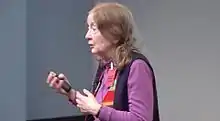Eugenia Kalnay
Eugenia Enriqueta Kálnay de Rivas (born 1 October 1942) is an Argentine meteorologist and a Distinguished University Professor of Atmospheric and Oceanic Science, which is part of the University of Maryland College of Computer, Mathematical, and Natural Sciences at the University of Maryland, College Park in the United States.
Eugenia Kalnay | |
|---|---|
 | |
| Born | 1 October 1942 (age 78) |
| Nationality | Argentina |
| Scientific career | |
| Fields | Meteorology |
| Institutions | University of Maryland |
| Doctoral advisor | Jule Gregory Charney |
She is the recipient of the 54th International Meteorological Organization Prize in 2009 from the World Meteorological Organization for her work on numerical weather prediction, data assimilation, and ensemble forecasting. As Director of the Environmental Modeling Center of the National Centers for Environmental Prediction (NCEP), Kalnay published the 1996 NCEP reanalysis paper, entitled “The NCEP/NCAR 40-year reanalysis project”, which is one of the most cited papers in the geosciences.[1] She is listed as the author or co-author on over 120 scientific papers and wrote the book Atmospheric Modeling, Data Assimilation and Predictability, which was published by Cambridge University Press in 2003.
Life
Kalnay was born in Argentina and received her undergraduate degree in meteorology from the University of Buenos Aires in 1965. In 1971, Kalnay became the first woman to receive a PhD in meteorology from MIT,[2] where she was advised by Jule Charney. She then became the first female professor in the MIT Department of Meteorology. In 1979 she moved to NASA Goddard[3] and in 1984 became Head of the Global Modeling and Simulation Branch at the Goddard Laboratory for Atmospheres.[4] From 1987 to 1997, Kalnay was the Director of the Environmental Modeling Center (EMC) of the National Centers for Environmental Prediction (NCEP), National Weather Service (NWS) and oversaw the NCEP/NCAR reanalysis project and numerous other projects in data assimilation and ensemble forecasting. After leaving NCEP, Kalnay became the Robert E. Lowry Chair of the School of Meteorology at the University of Oklahoma. In 2002, Kalnay joined the Department of Atmospheric and Oceanic Science at the University of Maryland, College Park and served as chair of the department. Along with James A. Yorke, she co-founded the Weather/Chaos Group at the University of Maryland, which has made discoveries of the local, low-dimensionality of unstable atmospheric regions and the development of the Local Ensemble Kalman filter and Local Ensemble Transform Kalman Filter data assimilation methods. In addition to the Atmospheric and Ocean Department (AOSC), Kalnay has appointments in the Institute for Physical Science and Technology (IPST) and the Center for Computational Science and Mathematical Modeling (CSCAMM), also at the University of Maryland, College Park. In 2008, she was selected as the first Eugenia Brin Endowed Professorship in Data Assimilation.
Among the scientific methods Kalnay has pioneered are the breeding method, which was introduced, along with Zoltan Toth, as a method to identify the growing perturbations in a dynamical system. She was also co-author on papers introducing the ensemble methods of Lag Averaged Forecasting (LAF) and Scaled LAF (with Ross N. Hoffman and Wesley Ebisuzaki).
In 2017, Kalnay was part of an international team of distinguished scientists who published a study on climate change models in the National Science Review journal. The study argues that there are crucial components missing from current climate models that inform about environmental, climatic and economic policies. Kalnay observed that, without including the real feedbacks, predictions for coupled systems cannot work and the model can get away from reality very quickly.[5]
Positions
Kalnay is a fellow of the American Geophysical Union,[6] the American Meteorological Society, the American Association for the Advancement of Science, and the American Academy of Arts and Sciences.[7] She is a member of the National Academy of Engineering (1996), a foreign member of the Academia Europaea (2000), and a member of the Argentine National Academy of Physical Sciences (2003).
Awards
Kalnay has received a number of major awards, including:[8]
- American Geophysical Union's Roger Revelle Medal (2019)[9]
- American Meteorological Society Eugenia Kalnay Symposium (2015)
- American Meteorological Society Honorary Member Award (2015)
- American Meteorological Society Joanne Simpson Mentorship Award (2015)
- Lorenz Lecturer (2012), a lecture named after Edward Lorenz and presented at the American Geophysical Union Fall Meeting[10]
- 54th International Meteorological Organization Prize (2009) from the World Meteorological Organization[11]
- Doctor Honoris Causa, University of Buenos Aires (2008)
- First Eugenia Brin Professorship in Data Assimilation (2008)
- Distinguished University Professor, University of Maryland (2001)
- Bjerknes Lecturer (1999), an American Geophysical Union lecture named after Jacob Bjerknes[12]
- American Meteorological Society Jule G. Charney Award (1995)
- National Aeronautics and Space Administration gold medal for Exceptional Scientific Achievement (1981)
References
- "NCAR Scientific Report". NCAR.
- "National Academy of Engineering". National Academy of Engineering.
- "Eugenia Kalnay". Interamerican Network of Academies of Science.
- "Population and Climate Change: Coupling Human and Nature Models". American Physical Society.
- "Critical components missing from current climate change models, says global study | Latest News & Updates at Daily News & Analysis". dna. 2017-02-10. Retrieved 2018-02-03.
- "Kalnay - Honors Program". Honors Program. Retrieved 2017-10-02.
- "Alphabetical Index of Active Members" (PDF). American Academy of Arts & Sciences. Retrieved 25 September 2017.
- "Eugenia Kalnay".
- "Roger Revelle Medal". Retrieved 12 December 2019.
- "Lorenz Lecture". American Geophysical Union. Retrieved 6 September 2017.
- "DR EUGENIA KALNAY WINS 54th IMO PRIZE". World Meteorological Organization.
- "Bjerknes Lecture". American Geophysical Union. Retrieved 25 October 2017.